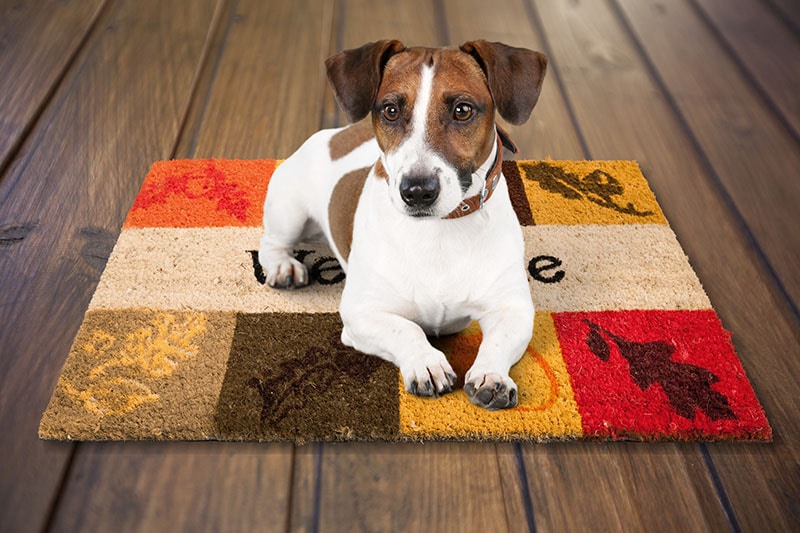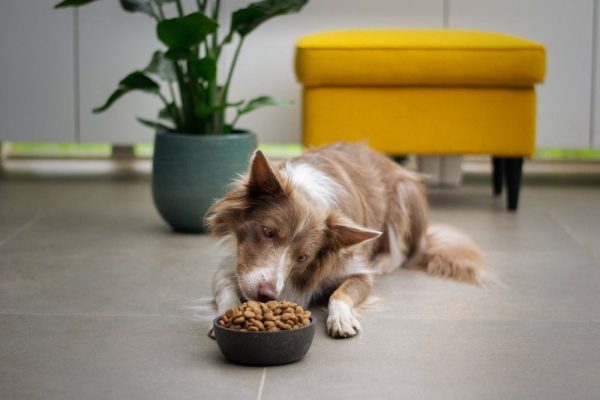In this article
View 2 More +Mat training is becoming a popular technique for teaching dogs. It involves using a mat or elevated bed to command your dog to relax when there is a lot of commotion. Rather than using a bed or other familiar item that your dog associates with sleep, your dog will quickly learn that the mat is a timeout spot and a place for them to relax.
You may have trouble getting started, but soon, you will have a well-trained canine who can use the mat. To simplify the process, we’ll show you how to teach your dog to use a mat.

Dog Mat Training in 8 Simple Steps
1. Buy the Right Mat or Elevated Bed
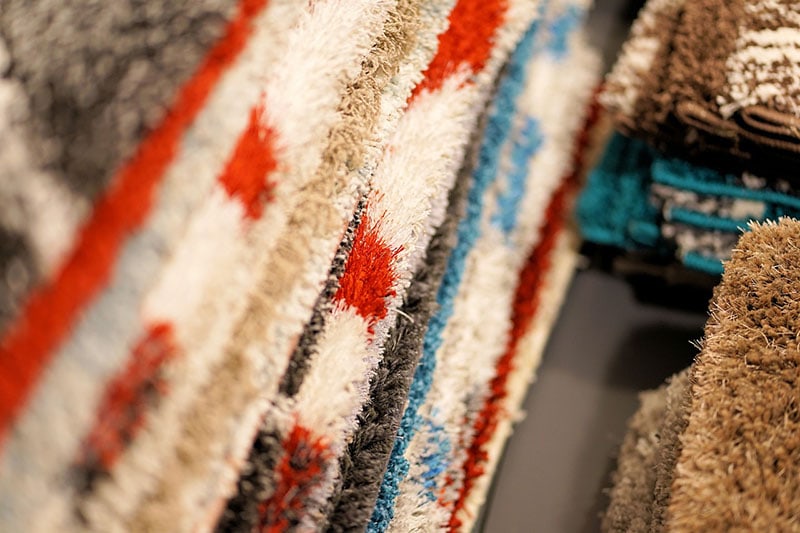
The first step in mat training is getting the correct mat. Some owners get elevated mats because larger dogs or those with longer hair can get overheated. This helps keep adequate airflow underneath your dog. Other pet parents use a flat mat that lays on the floor. Most of these mats are slip-free, so they stick to the floor without moving around. We highly recommend slip-free bottoms, as you don’t want much movement happening while you are training since it can be distracting.
You can find several mats on sites like Chewy or Amazon. Remember to get the correct size to keep your dog comfortable, too.
2. Build a Solid Comfort Level
Your dog must check out the mat to see if it passes inspection. You can gleefully show your dog the mat, using positive inflection to motivate them to check it out. To keep everything within the realm of your dog’s attention span, keep intervals between 3 and 5 minutes. Some dogs might require more motivation and others will take a bit longer.
Once your dog starts sniffing around, you’re halfway there. Next is to encourage your dog to use it on command. After all, it’s just a mat on the floor with no special tricks or gadgets, so they might need some direction.
3. Use Rewards

There’s nothing like using a tasty treat to get your dog’s attention. Scatter a few treats on the mat or encourage them to sit on it before giving out the goodies. The key is to give your pup a little attention while they eat the treats. Simply allow them to associate the treat with the mat and not with praise.
We recommend using dry treats you can stash in your pockets. After all, when you command your dog to go to the mat, you’ll initially need to convince them to obey.
4. Add a Command
When teaching your dog to go to its mat, you need a simple phrase to get started. You can say something short and clear, such as “Mat,” while pointing your finger in the right direction. The simpler you make it, the easier it will be for your dog to catch on.
You want to use the same phrase every time, as giving different directions can confuse your dog and prolong training. So, no matter the reason for wanting your dog to go to their mat, the command will sound the same.
Rather than handing your dog a treat while they’re on their mat, it’s best to toss the treat down instead.
5. Use Release Cues
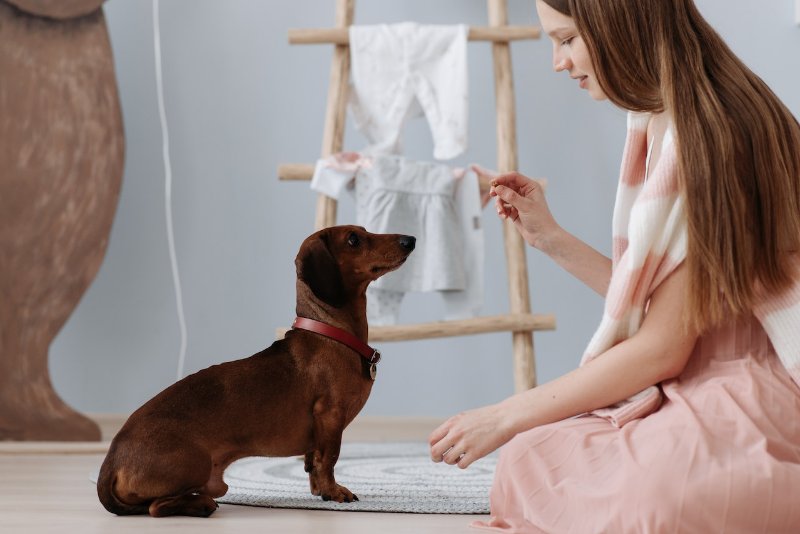
When you are ready for your dog to leave the mat, use a release cue to tell your pup when training is over. Like commands, release cues should be simple and consistent. You can use whatever phrase you’d like, but words such as “All done”, “Go on”, or “Free” can work.
It’s vital to use these cues in combination with all commands early in training. Your dog will eventually learn the cues and follow your instructions.
6. Test the Waters
The more you think your dog gets the hang of it, the more you want to test the theory. One successful way to do this is to increase the distance, add distractions, and increase the duration of time on the mat. The more you add these elements, the more challenging training will become. However, it will also teach your dog to handle real-life situations when the excitement in the home might be overwhelming. It’s something that you will want to start small and end big.
Here’s an example of how to increase time on the mat:
- 3–5 seconds
- 10 seconds
- 20 seconds and step away
- 30 seconds (with treats every 5)
After each interval, you can use your release cue to dismiss your dog and reward them. You can slowly replace the treats with a toy, so your dog doesn’t always rely on treat training as a reward. You can move at your dog’s pace; every pup will learn at a different rate. The idea is to keep your dog’s attention and alleviate the frustration associated with training.
The idea is to get your dog to perform this action regardless of what’s going on in the environment. So, you may add as many distractions as necessary to ensure they’re getting the hang of it. However, if it seems like your dog needs help or you need more support with training, take as many breaks as needed.
7. Try It Out Away from Home
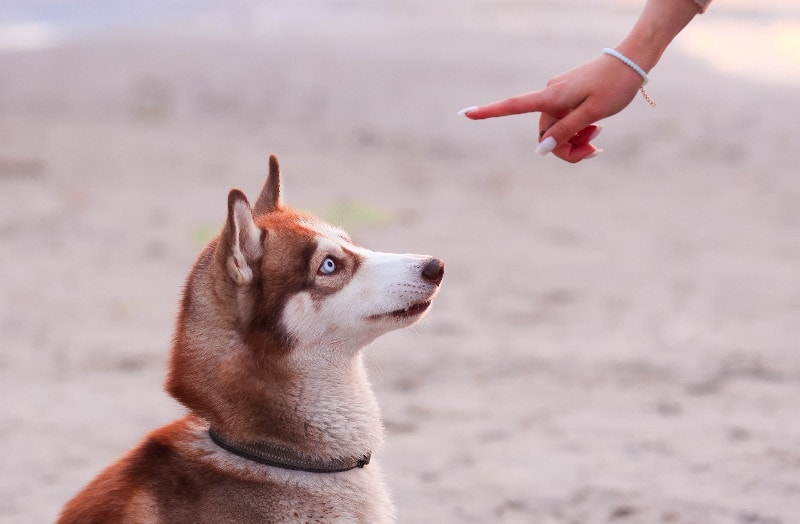
It’s one thing if your dog obeys you in your home. The real trick is getting them to listen when you are elsewhere. You can start small by taking your mat outside or to a dog-friendly facility to practice.
You can use the mat in the backyard, front porch, or at the local park.
8. Be Consistent
When training, it’s important to be consistent. If you don’t repeat the necessary commands followed by actions consistently, it can take your dog a lot longer to catch on. There’s no need to create any confusion along the way.

Benefits of Mat Training
Mat training provides a calming alternative for your dog when your house is chaotic. Whether a passerby, a knock on the door, or another kind of stimulation, mat training helps excitable dogs take a breather.
Much like teaching your dog to use a kennel, mat training can be equally beneficial in your home. It creates a consistent routine where your dog knows their boundaries.
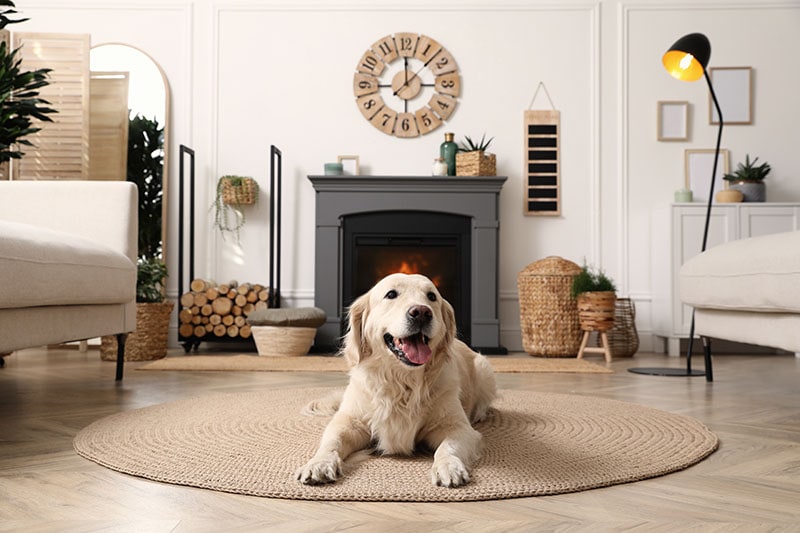
In a nutshell, mat training:
- Creates structure
- Provides a calming alternative
- Gives your dog direction
- Asserts boundaries
- Teaches obedience
Teaching your dog to go to a mat is equivalent to teaching your child to go to their room. It creates a safe space where your dog can relax and recuperate from whatever stimulation happens in the home.
Don’t Use a Dog Bed
You don’t want to confuse your dog’s sanctuary with their learning space. If you try to combine a dog bed and a training mat, it can have negative connotations. We want our dogs to know that the mat is associated with specific behaviors depending on the command.

Conclusion
Getting your dog used to their mat mainly consists of ensuring that they’re comfortable. Once your dog is relaxed, you can slowly start the training process, utilizing different commands and training techniques. Once your dog becomes accustomed to the mat, it will be a safe space to continue learning.
Before long, your dog will use the mat whenever they’re instructed to do so. Remember, you should never use their bed or another napping spot, as this can confuse or impact their relationship with their peaceful spaces.
- See also: How to Teach a Dog to Shake In 10 Steps
Featured Image Credit: Olga Alper, Shutterstock

